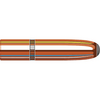For target use, it would be a center of gravity/center of pressure thing. One might be favorable to a different twist or chamber configuration. A spire point shifts the mass rearward in relation to a secant ogive. Center of gravity further to the rear is going to favor a faster twist. This is why some bullets of same weight but different configuration may or may not stabilise in a given twist. A hollow point moves the mass away from bullet axis, thus it is less sensitive to twist.
Yikes!!
How would I be able to know a bullets center of gravity?
How would I know the pressure generated, other than what is published in reloading manuals? Usually, if they publish pressure data, it's with a completely different rifle and powder.
Since I don't plan on replacing the barrel on my rifle(s) anytime soon, I'm stuck with the twist ratio I got, 1:10 I think.
I'm shooting two rifles, both Savage's, Trophy Hunter 22" barrel, Long Range Hunter 26", .308 bolt actions.
Usually I use 168 gr HPBT/FMJBT of whatever's on sale, quite often Hornady #3037 or polymer tipped BT's of Midway cheapies.
I don't have a clue as to what design they are, secant, tangent or hybrid. Whatever they may be I've had outstanding results and horrible results with everything else being the same.
I primarily use Accurate 2460 @ 40.0 grs with 90% of the brass being Lake City.
I don't sort by weight/volume or even lot #, at least not very often.
Some of the brass has been reloaded many many times, perhaps over 15 times.
I anneal the older brass after every use and discard any that show flaws. Most of the older brass does very well but not always.
I've also used Accurate 4064 and IMR 3031 but the 2460 is what I've used 90% of the time.
In the last 2.5 years I've shot somewhere in the neighborhood of 30,000+ rounds and within the last 4-6 months have had decent results sometimes stellar results even out to 600 yards...but not always. Consistency is really the issue. I don't get the same results every time.
I shoot at about 9000 ft altitude year round, hot/cold weather and everything in between no less than once a week with somewhere between 200-500 rounds per session depending on wind and my old bones being up to the task.
Maybe I'm as good as I'm going to get with what I use and got. How would I know?







